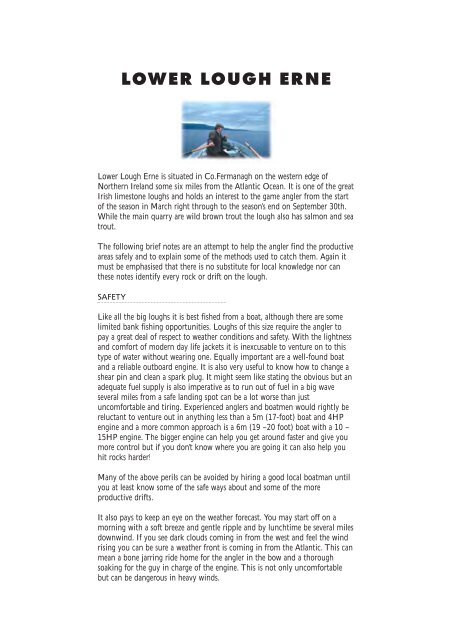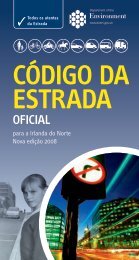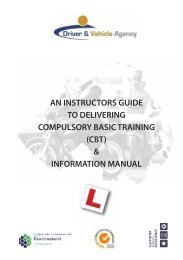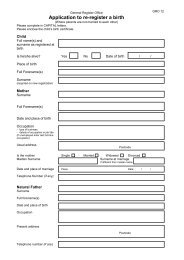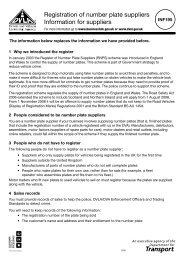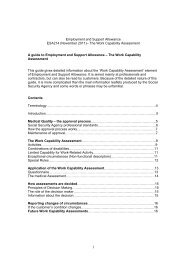Create successful ePaper yourself
Turn your PDF publications into a flip-book with our unique Google optimized e-Paper software.
LOWER LOUGH ERNE<br />
<strong>Lower</strong> <strong>Lough</strong> <strong>Erne</strong> is situated in Co.Fermanagh on the western edge of<br />
Northern Ireland some six miles from the Atlantic Ocean. It is one of the great<br />
Irish limestone loughs and holds an interest to the game angler from the start<br />
of the season in March right through to the season’s end on September 30th.<br />
While the main quarry are wild brown trout the lough also has salmon and sea<br />
trout.<br />
The following brief notes are an attempt to help the angler find the productive<br />
areas safely and to explain some of the methods used to catch them. Again it<br />
must be emphasised that there is no substitute for local knowledge nor can<br />
these notes identify every rock or drift on the lough.<br />
SAFETY<br />
Like all the big loughs it is best fished from a boat, although there are some<br />
limited bank fishing opportunities. <strong>Lough</strong>s of this size require the angler to<br />
pay a great deal of respect to weather conditions and safety. With the lightness<br />
and comfort of modern day life jackets it is inexcusable to venture on to this<br />
type of water without wearing one. Equally important are a well-found boat<br />
and a reliable outboard engine. It is also very useful to know how to change a<br />
shear pin and clean a spark plug. It might seem like stating the obvious but an<br />
adequate fuel supply is also imperative as to run out of fuel in a big wave<br />
several miles from a safe landing spot can be a lot worse than just<br />
uncomfortable and tiring. Experienced anglers and boatmen would rightly be<br />
reluctant to venture out in anything less than a 5m (17-foot) boat and 4HP<br />
engine and a more common approach is a 6m (19 –20 foot) boat with a 10 –<br />
15HP engine. The bigger engine can help you get around faster and give you<br />
more control but if you don’t know where you are going it can also help you<br />
hit rocks harder!<br />
Many of the above perils can be avoided by hiring a good local boatman until<br />
you at least know some of the safe ways about and some of the more<br />
productive drifts.<br />
It also pays to keep an eye on the weather forecast. You may start off on a<br />
morning with a soft breeze and gentle ripple and by lunchtime be several miles<br />
downwind. If you see dark clouds coming in from the west and feel the wind<br />
rising you can be sure a weather front is coming in from the Atlantic. This can<br />
mean a bone jarring ride home for the angler in the bow and a thorough<br />
soaking for the guy in charge of the engine. This is not only uncomfortable<br />
but can be dangerous in heavy winds.
4 LOWER LOUGH ERNE<br />
If you do get caught out in a big wave it is always safer to head into them with<br />
the boat at a slight angle so as it takes the waves on its shoulder. Running<br />
before a big wave can appear exhilarating but if you get out of sequence you<br />
can get pooped and this is perhaps the most dangerous way to take water.<br />
Again going across a heavy sea can be both uncomfortable and dangerous. It<br />
often pays to take shelter in the lee of an island until conditions settle down.<br />
Although the navigation markers are principally designed for use by the<br />
cruisers and bigger boats they are a useful guide for the angler as well and by<br />
keeping to the white side you will always know that you are in relatively deep<br />
and thus safe water.<br />
TROUT FISHING<br />
The lough opens for trout fishing on the 1st March and closes on the 30th<br />
September. Early in the season the fly fisher may have to use sinking or sink<br />
tip lines with flies like the Claret Dabbler and shrimp patterns being effective.<br />
As the water and weather warm up there will be more surface activity with<br />
olive and sedge imitations coming to the fore.<br />
For many the highlight of the season is mayfly time which is usually from mid<br />
May through to the middle or end of June. This is traditionally when the<br />
trout, including some of the bigger specimens, can be attracted to the surface<br />
away from the rich bottom feeding. Undoubtedly this is when there is most<br />
surface activity and increasingly anglers seem to be using dry flies as opposed<br />
to the traditional wet patterns such as the goslings. A big wild trout coming up<br />
to take your dry imitation has got to be one of game anglings most exciting<br />
sights. Most of the trout at this time of year will be from 1.5lbs to 3.0lbs with<br />
the occasional ‘bullock’ from 5lbs to 10lbs.<br />
There are many useful patterns for the dry fly angler to try at this time<br />
including the ever-popular Grey Wulff, Green Wulff, Humpy and<br />
Klinkhammers to imitate the dun or emerging dun. Spent patterns become<br />
increasingly important as time moves on and flies such as the Inny Spent,<br />
Grizzle Spent and the more modern creations made from Cul de Canard<br />
feathers can all be deadly. The trout can become very choosy with both the<br />
dun and spent mayflies and it pays to have a selection of both types of patterns<br />
in different shades and sizes. On an ideal day you could be fishing dun<br />
patterns up until late afternoon or early evening and then taking a break<br />
before the gnat begins to come out and fall on a warm still balmy evening. In<br />
reality this does not happen too often and the spent gnats may start to trickle<br />
out from the middle of the afternoon. However once the trout have got a taste<br />
for the spent they often will take it even if the dun is still hatching. Those new<br />
to dry fly fishing on loughs may imagine that you fish with just one fly on<br />
your cast. The more experienced will usually have two, three or even four flies
LOWER LOUGH ERNE<br />
floating out in front of them Apart from the obvious fact that you can fish a<br />
selection of patterns it is actually easier on the eye to be concentrating on two<br />
or three objects.<br />
As the mayfly draws to a close there can be some good sedge fishing in the<br />
evenings. The trout at this time will usually then start to concentrate on fry<br />
feeding and can become exceedingly frustrating to try and catch!<br />
By the time August arrives there can be a secondary hatch of Mayfly, Olives<br />
and Sedges or falls of Daddy Long Legs and from the middle of this month to<br />
the end of the season fishing activity can pick up nicely again.<br />
There is a biomass of some 40 –50 000kg of trout fairly evenly distributed<br />
throughout the lough but they do move around quite a bit. A bay that one day<br />
seems to be full of fish may be practically devoid of action the following<br />
therefore the angler has to be prepared to search for the fish.<br />
In such a vast piece of water it is difficult for those new to the lough to know<br />
where to start and the best advice, as stated before, is to get a local guide or<br />
ghillie for a few days.<br />
The following is a brief trip around the lough starting at the western end,<br />
where the mayfly traditionally begins to hatch, anywhere from Rosscor to<br />
Stony Island (see Sheet 1). Perhaps the best known landmark in this area is<br />
Gubnagole Point, which is better known as ‘the Eagle’. Around the islands<br />
and shallows along the shores from here to Loftus, Bingham and Round Island<br />
(see Sheet 2) there are many good drifts and bays. To the north of Boa Island<br />
is an area of the lough known as the ‘wee lough’ or ‘little <strong>Lough</strong> <strong>Erne</strong>’. The<br />
‘wee lough’ has some very large and more often than not dour trout, but it is<br />
also not as well charted as the main lough. It is sometimes a more sheltered<br />
route westward but anglers should stick to the Boa shore as the northern or<br />
Letter shore is a mass of rocks and requires careful navigation. The Lusty<br />
Islands (see Sheet 3) and the surrounding islets such as Screegan (often known<br />
as Gull Island) can be very productive throughout the season. There is wealth<br />
of fishing from Kesh Bay (see Sheet 4) around the shorelines and islands<br />
although anglers should be aware that the area around Muckross and<br />
Drumrush can attract a lot of water sports. I know from personal experience<br />
why Gubbaroe Point is also known as Cape Horn (something to do with very<br />
rough water conditions!) but there are some very nice sheltered bays once you<br />
are in behind the islands. Castle Archdale (see Sheet 5) provides more<br />
interesting and productive shallows. As you move further south of Inish Garve<br />
(see Sheet 6) right down to Car Island the lough becomes narrower and there<br />
is increased cruiser traffic but with the improved water clarity this has now<br />
become an interesting area for the fly fisher. Heron Island and Tully Castle (see<br />
Sheet 7) were known as old salmon lies but they are also fine trout fishing<br />
ground.<br />
5
6 LOWER LOUGH ERNE<br />
Trolling is another way to take trout and is perhaps the most likely way to get<br />
hold of one of the monster fish the <strong>Lough</strong> holds. In the 90’s the Ferox 85<br />
Group visited <strong>Lower</strong> <strong>Lough</strong> <strong>Erne</strong> and from their short stay was convinced<br />
there was the possibility of a record trout. There have been several trout caught<br />
in the high teens of pounds and lures like the Tasmanian Devil and Rapalas<br />
can be very productive.<br />
SALMON FISHING<br />
There has been a considerable amount of work carried out to try and restablish<br />
a significant salmon population with last year seeing a substantial run. The<br />
occasional salmon and grilse have been taken on wet flies especially around the<br />
area from Rosscor to Ferny Island (see Sheet 1). The south shore from Hills<br />
Island down to Heron Island and Tully Castle (see Sheets 1, 2 & 7) is the most<br />
likely spot to take a salmon on the troll.<br />
FLY FISHING FOR PIKE<br />
There is a good head of pike and they can provide great sport on a trout rod.<br />
Fly-fishing for this superb predatory fish has become increasingly popular with<br />
the use of big streamer like flies such as the Ballydoolagh Bomber. When the<br />
trout are off the angler can have great fun in a number of bays such as those in<br />
Castle Caldwell (see Sheet 1) although it is important to have the right<br />
equipment and know how to safely handle Esox Lucious.<br />
GHILLIES & BOATHIRE<br />
Belleek Angling centre<br />
The Thatch, The River <strong>Erne</strong>, Belleek, Co. Fermanagh, N. Ireland BT93 3FX<br />
Tel/Fax. 028 686 58181; e-mail cottages@freezone.co.uk<br />
Sean Maguire<br />
Melvin Angling, Garrison, Co.Fermanagh, BT93 6ER<br />
Tel 028 686 58194<br />
Philip Keers<br />
The cottage, Manville house, Letter, Kesh, Co. Fermanagh, BT93 2BF<br />
Tel. 07711 697525<br />
David Stinson<br />
Dreenan Cottage, Dreenan, Boa Island, Co. Fermanagh, BT93 8AA,<br />
Tel. 028 686 31951, e-mail fisherdavy@aol.com
ANGLING HOLIDAY ORGANISERS<br />
Michael Short<br />
Qualified Fly Casting Instructor, Flatfield Fly Fishing, Flatfield, Sydare,<br />
Ballinamallard, BT94 2DU,<br />
Tel 028 66 388184<br />
John Todd<br />
Gillaroo Angles, 7 Cooleen Park, Jordanstown, Co. Antrim BT37 ORR.<br />
Tel. 028 90 862419<br />
Sean Maguire<br />
Melvin Angling, Garrison, Co. Fermanagh, BT93 4ER,<br />
Tel 028 686 58194<br />
Davy Stinson<br />
Dreenan Cottage, Dreenan, Boa island, Co.Fermanagh, BT93 8AA<br />
Tel. 028 686 31951, e-mail fisherdavy@aol.com<br />
LOWER LOUGH ERNE 7<br />
Belleek Angling Centre<br />
The Thatch, The river <strong>Erne</strong>, Belleek, Co. Fermanagh, N. Ireland BT93 3FX<br />
Tel/Fax 028 686 58181; e-mail cottages@freezone.co.uk<br />
TACKLE SHOPS & FLY TYERS<br />
Frankie McPhilips<br />
Fly Dresser, The Buttermarket Craft Centre, Down Street, Enniskillen,<br />
Tel. 028 66 323047, e-mail fmcphillips@swiftsoft.net<br />
Sean Maguire<br />
Melvin angling, Garrison, Co. Fermanagh,<br />
Tel 028 68658194<br />
Belleek Angling Centre<br />
The Thatch, The River <strong>Erne</strong>, Belleek, Co. Fermanagh, N. Ireland, BT93 3FX,<br />
Tel/Fax 028 686 58181, e-mail cottages@freezone.co.uk<br />
Home Field & Stream<br />
18 Church street, Enniskillen,<br />
Tel 028 66 322114, Fax 028 66 327335<br />
Mullen’s Pet & Shooting Supplies<br />
Unit 3, Scotch store bridge, Sligo road,<br />
Enniskillen Tel 028 66 324975<br />
Country Sports<br />
52 Drumadravey Road, Irvinestown,<br />
Co. Fermanagh, N. Ireland.<br />
Tel/Fax 028 686 21788
8 LOWER LOUGH ERNE<br />
MAP 1<br />
MAP 2<br />
MAP 3<br />
MAP 7<br />
MAP 4<br />
MAP 5<br />
MAP 6
N<br />
Traditionally the mayfly fishing starts from around the middle of May from Ferny Island westwards. Also good fly fishing around Buck, Gravelly and<br />
Croghan’s Islands as well as Gubnagole Point. (‘The Eagle’)
10 LOWER LOUGH ERNE<br />
LOUGH ERNE GOSLING<br />
TAIL Three Fibres Cock Pheasant Tail<br />
BODY Medium Olive Seal’s Fur<br />
RIB Oval Gold<br />
HACKLES i) Scarlet Cock<br />
ii) Grey Speckled Mallard dyed yellow
Good drifts from Loftus Island along the northern shore to Round Ialand in a south west to west<br />
wind. Southern shore is often more suited to trolling.<br />
N
12 LOWER LOUGH ERNE<br />
GOLDEN OLIVE BUMBLE<br />
TAIL Golden Pheasant Topping<br />
BODY Golden Olive Seal’s Fur<br />
RIB Oval Gold<br />
BODY HACKLES Golden Olive and natural medium Red Cock<br />
SHOULDER HACKLES Two Turns of Blue Jay
Access Guide - <strong>Lower</strong> <strong>Lough</strong> <strong>Erne</strong> Sh 3<br />
Public Launching Point<br />
Warning<br />
<strong>Lough</strong> becomes rough in strong winds<br />
Scale: 1:25 000<br />
(approx 2.5 ins - 1 Mile or 1cm - 0·25 Kms)<br />
Based on OSNI <strong>Lower</strong> <strong>Lough</strong> <strong>Erne</strong> Outdoor Pursuit <strong>Map</strong>. Permit No 1154<br />
Produced by Ordnance Survey of Northern Ireland<br />
© Crown Copyright 1998<br />
Excellent fly fishing opportunities around all the islands to the south of Boa Island. Both Lusty More<br />
and Lusty Beg can provide shelter from strong winds.<br />
N
14 LOWER LOUGH ERNE<br />
CLARET DABBLER<br />
TAIL Golden Pheasant Cock Tail Fibres<br />
BODY Claret Seal’s Fur<br />
RIB Oval Gold<br />
HACKLES Claret Cock<br />
WING Bronze Mallard tied all round
N<br />
Good fly fishing opportunities around all the islands although from Hare Island to Muckmoss Point<br />
can become busy with watersports activities. It can become rough around Gubbaroe Point in strong<br />
winds.
16 LOWER LOUGH ERNE<br />
FIERY BROWN<br />
TAIL Golden Pheasant Tippets<br />
BODY Fiery Brown Seal’s Fur<br />
RIB Oval Gold<br />
HACKLE Fiery Brown<br />
WING Bronze Mallard
N<br />
Good trout fishing around the shallows<br />
on the eastern shore near Castledale<br />
and around the islands.
18 LOWER LOUGH ERNE<br />
GREEN WULFF<br />
TAIL Brown Squirrel Hair<br />
BODY Pea Green Seal’s Fur<br />
RIB Oval Gold<br />
HACKLES Two Green Cock Hackles<br />
WING Brown Squirrel Hair
As the lough is narrower here the engler may expect more contact with cruisers<br />
however trout can still be caught around the islands and in the shallows.<br />
N
20 LOWER LOUGH ERNE<br />
DADDY LONG LEGS<br />
BODY Golden Pheasant Tail Cock Fibres<br />
RIB Fine Oval Gold<br />
HACKLES Two Natural Red Game<br />
LEGS Six Knotted Cock Pheasant Tail Fibres<br />
WINGS Two Grizzle Hackle Points
The area around Heron Island and Tully Castle is an old salmon lie and there are trout in the shallows.<br />
N
22 LOWER LOUGH ERNE<br />
BADGER SPENT GNAT<br />
TAIL Golden Pheasant Cock Tail Fibres<br />
RIB Fine Oval Gold<br />
BODY Grey Seal’s Fur or Dubbing<br />
HACKLES Two Badger Cock Hackles<br />
WING Two Black Cock Hackle Points


